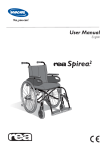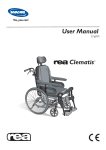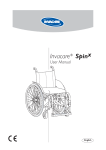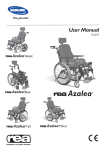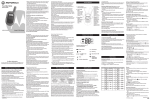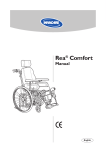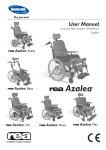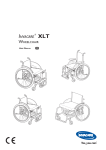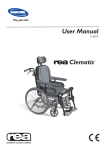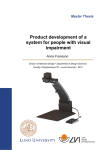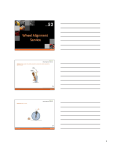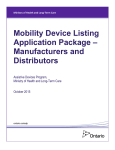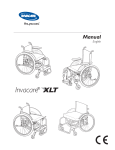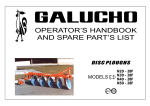Download Focus user manual (PDF 2 Mo)
Transcript
User Manual
English
Focus
TM
©Invacare Rea AB
Every effort has been made to ensure that the contents of this
publication are updated at the time of printing. As part of the
ongoing improvement of the products, Invacare Rea AB reserves
the right to modify existing models at any time.
Any use of this publication, or parts thereof, as well as any reproduction of images, must have the written consent of Invacare
Rea AB
Contents
Product description
Intended use
Delivery check
Daily performance check
Safety
Parts of the wheelchair
Lifting the wheelchair
Upholstery and frame colours
Accessories
Technical data
4
4
5
5
5
6
7
8
8
9
Assembly
10
Settings
Angle adjustable legrests
Fixed legrests
Footplates/calf pads
Seat
Backrest
Armrests
Push handles
Rear wheels, adjustment
Castor adjustment
Brakes
Carer-operated brake
Wheelchair heights
12
12
12
13
14
15
16
16
17
18
19
19
20
Accessories
Amputee legrest
Biangular backrest
Reclining backrest
Reclining backrest gas spring
Trunk support for
Reclining backrest gas spring
Head and neckrest
Anti-tip devices
Pelvic belt
26
26
26
27
28
29
29
30
31
33
Transporting wheelchairs in vehicles
Restraint methods
34
36
Safety instructions/Propelling techniques
38
Maintenance
40
Focus
TM
3
Product description
Rea™ Focus™
Rea™ Focus™is a wheelchair with many adjustment options and
accessories. To ensure that you benefit as much as possible from
Rea™ Focus™, and in order to do its options justice, the chair must
be tested and adjusted by competent personnel. We hope that
you have also received instructions for using your Rea™ Focus™
in everyday life.
The Rea™ Focus™ frame, legrests and hand rims are manufactured
from high quality aluminium.
The telescopic backrest tubes and the inner part of the legrest
tubes, are made from steel.
The seat is made of plastic and is easily cleaned. The cushion and
backrest are made of either polyester or plush fabric.
This manual includes a description of the parts of the chair, simple
adjustment options, how to use the Rea™ Focus™ safely and how
to transport it. The manual must be read thoroughly before the
chair is used.
Also included in this manual is a description of how the most
common accessories are fitted and more advanced settings.
As the Rea™ Focus™ has many different components and accessories, the appearance of the accessories you have for your chair
may differ from those shown.
Intended use
wheelchair over longer periods of time (several hours) and need
support when sitting.
wheelchair themselves but also for people needing aid by an
assistant.
properly and comfortable seated for many hours per day.
!"" # Focus™ can be used indoors and outdoors. We recommend
the use of the big castors for running on bumpy ground.
$
%&
ally if the slope is 8° or more. Use anti tip devices (and common
sense)!
on the seat. There is a risk of pressure sore without the use of
a cushion.
%*+
if the wheelchair is not propelled by the feet and have a low seat
height.
4
Focus
TM
SAFETY
This symbol means warning.
On the next page a number of points affecting your
personal safety are shown. Read it carefully!
Invacare® is only responsible for product changes carried out by personnel who we authorise. We reserve the right to make any changes
to equipment and specifications without prior notice.
Failure to comply with instructions given may result in
personal injury and/or product damage.
:
;
<
! %
! ;%
! ;=>
%
$> % & &
backbrace or by the adjustable push handles.
?%%;
@
$>
&
because of the risk of tipping.
:>
;>@
G%
&
%
injury to your hands.
JK>%=>
> = ;
is reduced in wet and slippery conditions, as well as when on a
slope.
M
>
%
@
>
the chair.
G ; N% >
backrest become too slack. Always check the tension.
Be aware that if the wheelchair is left in the sun for a prolong period,
certan parts like the seat and frame will be very hot.
DELIVERY CHECK
Check that all components comply with the delivery note. Any damage
incurred during transport should be reported immediately to the delivery company. Retain all packaging until the transport company has
inspected the consignment and an agreement has been reached.
DAILY PERFORMANCE CHECK
Check that the following parts are proprely assembled on the wheel
<
O
M
;
?=>
Q
Focus
TM
5
Parts of the wheelchair
4
3
12
3
13
5
7
2
14
6
10
11
14
1
1.
2.
3.
4.
5.
6.
7.
8.
9.
10.
11.
12.
13.
14.
6
8
9
2
Frame (chassis)
Crossbrace
Backrest
Push handles
Seat
Rear wheel bracket
Rear wheel
Handrims
Brakes
Castors
Anti-tip devices
Armrests
Sideguards
Legrest
Focus
TM
LIFTING THE WHEELCHAIR
Always lift the wheelchair by gripping the frame at the
@$>
by the removable armrests or the foot-rests. Ensure
that the backrest and push bar are securely in place.
Also read the chapter Safety instructions/propelling
techniques.
Please observe that the backrest bar may not be used
for lifting the wheelchair
Focus
TM
7
Upholstery and frame colours
Upholstery
Black Jermima TR18, Grey Dartex TR23
Grey Plush TR32
Frame colours
Pearl Grey, Anthracite Black
Shining Blue
Accessories
Rea™ Focus™ has a wide range of accessories and options.
Z[$™ Focus™ 150
Backrest
Sling *
Tension adjustable with cover or backrest cushion
Biangular backrest *
Reclining backrest *
Seat
Firm seat plate with or without insert cushion
Seat cushions
5 cm standard
Different versions of seat cushions
Legrests
80° + 90° legrests
Legrests (angle-adjustable)
Plaster legrest
Amputee legrests
Fixed footplate
Angle-adjustable and depth-adjustable foot plate *
Heel strap
Footplate extender
Armrests
Flip-up armrests *
Height adjustable armrest
Hemiplegic armrest
Autolock for armrests
Long pad wide or narrow
Short pad narrow
Castors
!""&
&@
140, 180, 200 mm, pneumatic or solid (Focus™ 150)
Rear wheels
16'', 20”, 22”, 24”, pneumatic or puncture-proof
Brake
Tyre brake Malta
Carer-operated
Extended brake arm
One arme brake *
Others
Several types of hand rim
Pump
Spoke guard
Cane holder
Anti-tip devices
Step tube
Reflectors Kit
Pelvic Belt
GG% z$
;
Trunk supports *
Wedges *
Push handles external and height adjustable
8
Focus
TM
Technical data
38 0/ 405 / 43 0/ 455 /
48 0/ 505 mm
{<|}! ~"
z<~ !""Z
G<~=""
||"! |"
"!
" "!
G<""="
320 mm
G<|"
{<| ! ~"
z<~!~"Z
Transit 430-465 mm
=! |
"! |"
16.2 kg
| "! }"
"! "
G<"=|
Seat width
+ 220 mm
}~!|"
max 135 kg
max 150 kg*
Transport weight
10 kg
Crash test**
* Rea™ Focus™ Heavy Duty in seat width 53 cm.
** Our wheelchairs comply with ISO norm 7176-19 and have been tested in a basic configuration. The use in other configurations has
not been tested. See section "Test report from dynamic safety restraint test", for test configuration. Wheelchair users should however
transfer to the vehicle seat and use the vehicle installed restraint system whenever it is feasible.
Focus
TM
9
Assembly
1. Attach the rear wheels by pressing the button in
the centre of the hub whilst simultaneously sliding
the axle into the rear wheel position attachment
of the positioning plate.
1.
It is very important that you check that the
locking pin has actually locked the wheel into
position when the centre button has been
released. Take hold of the wheels and try to
@G$G@
2.
B
A
2. There are two methods of unfolding the
seat.
A. Unfold the wheelchair by pushing the handle in the
middle of the seat right down.
B. Lift the rear wheels slightly up and pull the push
handles apart from each other. The seat plate falls
down with a "click" sound.
Be careful not to trap your fingers or part of
the hand between the seat-halves!
3.
3. ;
@$
that the small knob should be locked in its hole.
4.
4. Insert the armrest by fitting it into the attachment
on the backrest frame and then swing it down until
it fits into position.
Do not place any fingers on the seat frame. If
your chair has detachable armrests, just press
them in the receiver.
10
Focus
TM
5. Footrests/legrests
The wheelchair can be equipped with either footrests or legrests.
5a. Footrests
Attach the footrests by pushing the tube at the
upper part of the footrests down into the tubes
on the wheelchair. You must angle the footrests
outwards when inserting them.
Lock the footrests by turning them inwards. The
footrests are automatically locked so there is no
risk of them coming off the wheelchair.
5a.
Be careful not to trap your fingers between
frame and footrest.
5b.
A
5b. Legrests
Attach the legrests by pushing the tube at the
upper part of the legrests down into the tubes
on the wheelchair. You must angle the legrests
outwards when inserting them.
Lock the legrests by turning them inwards. The
legrests are automatically locked so there is no
risk of them coming off the wheelchair.
The legrest angle is adjusted by the knob (A).
Be careful not to trap your fingers between
frame and legrest.
The Brake lever
Please note the brake lever handle will have a
certain amount of free play. Without activating the
brake, the lever will fold up automatically when the
legrest has been moved to its outward position. To
activate the brake just push the lever forwards.
Focus
TM
11
Settings
ANGLE ADJUSTABLE LEGRESTS
Angle adjustable legrests support the legs and reduce
pressure. The legrests can be used for bandaged legs,
but not for legs in plaster casts. The legrests must
always be fitted with calf pads, footplates and heel
straps.
1.
It is important to adjust the height and angle of the
legrests to obtain a good seating position.
1. Height adjustment
Loosen screw (A) with an Allen key. Adjust the
legrest into a suitable height and the screw is
caught by one of the recesses on the legrest tube.
Then retighten the screw.
A
G<?%
2. Angle adjustment
Pull the lever (B) with one hand while supporting the legrest with your other hand. When a
suitable angle is obtained, let go of the lever and
the legrest will look into one of seven preset
positions (C).
2.
B
Do not place anything heavy, or let children
sit on the legrest. It may cause damage to the
mechanism.
The distance between the lowest part of
the footrest and the ground must be at least
40 mm.
C
FIXED LEGRESTS
90˚
80˚
C
Height adjustment
Loosen screw (A) with an Allen key. Adjust the legrest
into a suitable height and the screw is caught by one
of the recesses on the legrest tube. Then retighten
the screw.
A
NOTE! Don't touch the upper screw (C).
The distance between the lowest part of
the footrest and the ground must be at least
40 mm.
G<?;%
12
Focus
TM
FOOTPLATES/CALF PADS
1. Angle-adjustable footplates
Adjust the angle and the depth by loosening the
screw (A) at the footplate attachment with a 5 mm
Allen key. Adjust the footplate to the correct
position and retighten the screw.
1.
Do not place anything on the footplate when
the screw is loose.
A
G<?;%
C
D
2.
B
2. Calf pads
The calf pads can be fitted in two different depth
positions. Swing the pad forwards. Unscrew (B)
using an Allen key. Remove the large nut (C) on the
reverse side and place it in the other attachment
hole. Move the calf pad to the new position and
secure it into place with the screw.
The height of the calf pads can easily be adjusted
using the handwheel (D).
G<?;%
Focus
TM
13
SEAT
1.
1. Seat without inlay cushion.
2.
2. Seat with inlay cushion.
3. Adjusting seat fronts
You can adjust the seat fronts, one at a time.
Loosen screw (A). Pull the seat front into desired
position (max. 5 cm). Retighten the screw again.
3.
A
Adjust only within the marked area.
4. Removing seat front
You can remove the seat fronts, one at a time.
Just loosen screw (A) and pull the seat front
right out.
4.
A
5.
6.
5. Inlay cushion
For obtaining a flat seat the inlay cushion is inserted
as shown on the picture.
6. Adjusting the seat depth
Remove the armrests. Loosen the two screws
(B) and push the backpipe to desired postition.
Retighten the screw.
B
If the seat depth is adjusted backwards without moving the rear wheels back, there is an
increased risk of the chair tipping back.
G<?;%
7.
D
7. Adjusting the seat width
You can increase the seat width 2.5 cm. Remove
the armrests and the seat cusion. Loosen the two
screws (C) and change the position.
If the wheelchair has flip-up armrests you also have
to loosen screw (D) at the end of the frame tube
and change the tube position accordingly.
Retighten screws (C) and (D).
C
G<?;%
14
Focus
TM
BACKREST
Adjusting the backrest height
1.
1. Use a pair of scissors to remove the plastic ties
(A) at the bottom of the backcloth. Then fold the
chair slightly by lifting the seat upwards.
Always attach new straps when the backrest
has been adjusted. Tighten them well.
A
2.
2. Loosen screws (B) on the rear of the backpipe
with an Allen key. It is now possible to lower and
raise the back. Retighten the screws again.
When adjustment is complete, secure the backcloth with new plastic ties.
Velcro backrest
G<?;%
B
3.
If the backrest has been adjusted to a higher level,
fold down the bottom part of the Velcro upholstery. It should cover the backrest as much as possible. Remember to fixate the lowest strap in the
backrest brackets. The strap holds the upholstery
down.
3. Backrest shape
The shape of the backrest can be adjusted with the
Velcro straps.
The user should sit in the chair while the backrest
is being adjusted. The shape can be adjusted with
the Velcro straps to satisfy the user's needs for
support and comfort. For example, the straps in
the lumbar region could be tightened to provide a
good support to the sway-back and enable a more
upright sitting position. When all adjustments are
done, fold back the backcloth and attach it with
4.
the Velcro straps.
4. Backrest angle
Loosen the screw (A) on the inside and screw (B)
on the outside of the back tube. Angle the back
to the desired position by turning the dial (C)
(between 6º forward or 13º backward) by hand
or with the Allen key.
Tighten the screws again.
Repeat the procedure on the opposite side.
A
B
G<?;%
Focus
TM
15
ARMRESTS
1.
Adjusting the height of the armrests
1. Flip-up armrest
If your chair is equipped with armrests that can be
raised or lowered, this is achieved by loosening the
screw (A), moving the armrest into the required
position and retightening the screws.
A
G<?;%
2. Detachable armrest
If your chair is equipped with armrests these can
be raised or lowered, by loosening the screw (B)
under the armrest. Move the armrest up or down
to the desired position and retighten the screw.
2.
G<?;%
3. Height adjustable armrest
Adjust the height of the armrests by turning the
knob or Allen key screw (C), setting the required
height and then re-tightening the knob/screw.
B
Depth
You can also adjust the depth of the armrest pad.
Loosen the knob (D), set the pad in the required
position and re-tighten the knob.
3.
C
D
When adjusting the height, do not put your
fingers between armrest pad and side plate as
they may get trapped.
PUSH HANDLES
1.
Adjusting the height of the push
handles
1. To raise or lower the height of the push handles
turn the knob and raise the handles to the required
height.Tighten when the correct position is
achieved.
2.
A
16
2. When hole (A) is visible, just above the attachment,
the handle will be in the right "locking-position".
Focus
TM
REAR WHEELS, ADJUSTMENT
1. Rear wheel depth adjustment
To obtain different wheel balance there are four different positions of the rearwheel bar.
The front and rear positions are easily found by pushing
the bar to its end positions.
The two middle positions is obtained by placing the bar
between the marks (D) or (E) on the attachment.
To adjust the position of the rearwheel bar, loosen the
screws (A and B) and let the screw-heads be visible
before you move the bar. Push/pull it to the desired
position and retighten the upper one (A) first and then
M#@$
%
locks when it is fully inserted.
B
A
C
1.
In addition the rear wheel can be placed in front of
or behind the bar. Loosen the screws (C) and turn
the clamp. Retighten the screws alternately. If not,
the clamp might get a slight obliqueness so that the
rearwheel will catch the armrest.
DE
The chair will be more unstable by positioning the rear
wheels in front of the bar. If the wheels are positioned
futher back the stability of the chair increases. Adjust
this by loosing the screws (C) and turn the rear wheel
attachment.
DE
G<?;%
The risk of tipping increases greatly if the rear
wheels are located in front of the backrest.
2.
2. Rear wheel height adjustment
Loosen the screws (C) and slide the clamp up or down
to desired position. A peg on the inside of the clamp fits
in the holes of the bar. Retighten the screws alternately.
If not, the clamp might get a slight obliqueness so that
the rearwheel will catch the armrest.
G<?;%
C
3.
3. Camber
Invacare Rea Focus has 0° or 2° rearwheel camber
depending on the rearwheel attachment. To change
the camber the rearwheel attachments need to be
changed. The 2° camber attachments have a round
marking (F) on the outside.
F
F
Focus
TM
When you have fitted the wheels in the correct
position, make sure that the nuts and screws are
tightened securely. The axle housing should be
tightened with a manual and dynamometric wrench
~" $@ G %
own safety!
Important
Make sure that the marking (F) on the 2° rearwheel attachments is placed upwards to obtain
the correct angle.
17
CASTOR ADJUSTMENT
Adjusting the castor angle
The castor can be angled in 5 different positions from
0° to 6°. When you have found the desired seat height
and depth, it’s important to check that the angle
between the castor attachment and surface is as close
to 90° as possible, as it may affect the wheelchairs
propelling ability.
1a.
A
1a. To adjust the angle, loosen the screw (A). Then
loosen screw (B) 2 turns.
B
1b. Pull out the adjustment screw (C) by hand.
1b.
C
1c. Turn the adjustment screw (C) to the desired angle
position by hand.
1c.
1d. When the desired angle has been found, push the
adjustment screw back into position and retighten
the screws (B) and (A).
C
Check that the castor is securely fitted after
adjustment.
1d.
A
B
2a.
Adjusting the castor height
(only for high castor attachment)
The castor can be adjusted to 3 different heights.
A
2a. To adjust the height, loosen the screw (A) by 7
turns and screw (B) 2 turns.
B
2b. Pull out the castor housing and move it to the
desired height.
2b.
2c. When the desired height has been found, push the
castor housing back into position and retighten the
screws (B) and (A).
2c.
A
Check that the castor attachment is securely
fitted after adjustment.
B
18
Focus
TM
BRAKES
1.
C
X
MA
To apply the brake to the chair, press the lever (A)
forwards. To release the brake, pull the lever backwards (towards you).
A
Take care not to trap your fingers between
the brake shaft and tyre.
Adjusting the brake
1. Check that the tyres are inflated to the correct air
pressure (indicated on the tyre wall). Then, using
an Allen key, loosen the screw and slide the brake
to the desired position and tighten. The correct
distance between the brake shaft (B) and the tyre
is approx. 15 mm.
B
C
X
MA
B
NB
The brake must not be moved further than indicated in the diagram opposite (C).
2.
2. If the brake requires further adjustment, loosen
screws (D), under the brake mounting and slide
the mounting to a new position. Retighten screws
(D).
D
Incorrect adjustments or use of the brake can
reduce the effectiveness of the brake.
G<?;%
CARER-OPERATED BRAKE
1.
1. ?%;><;
* # brake will be applied.
2.
2. {
;;<;
move the lock catch (A) upwards. Then release
the handle.
A
3.
3. ;<
the lock catch will release automatically.
Incorrect adjustments or use of the brake can
reduce the effectiveness of the brake.
Focus
TM
19
WHEELCHAIR HEIGHTS
24*13/8" HIGH
67
45
23
1
41,5
44
44
44
46,5
46,5
46,5
46,5
49
49
49
49
49*
51,5
51,5
51,5
51,5*
54*
3°
3°
3°
3°
3°
3°
3°
3°
3°
3°
3°
3°
3°
3°
3°
3°
3°
3°
13
11
11
11
9
9
9
9
7
7
7
7
7
5
5
5
5
3
4
2
3
3
$+?
1
1
2
$+?
$+?
$+?
$+?
1
$+?
$+?
$+?
$+?
$+?
$+?
$+?
$+?
$+?
3
4
4
$+?
1
2
2
3
4
1
1
2
3
1
7
5
$+?
6
3
$+?
4
$+?
1
$+?
2
$+?
4
$+?
1
$+?
3
1
125
125
140
150
125
140
150
180
125
140
150
180
200
140
150
180
200
200
7
5
$+?
6
3
$+?
4
$+?
1
$+?
2
$+?
4
$+?
1
$+?
3
1
125
125
140
150
125
140
150
180
125
140
150
180
200
140
150
180
200
200
$+?[$
Z[$
"
24*1" HIGH
67
45
23
1
41,5
44
44
44
46,5
46,5
46,5
46,5
49
49
49
49
49*
51,5
51,5
51,5
51,5*
54*
3°
3°
3°
3°
3°
3°
3°
3°
3°
3°
3°
3°
3°
3°
3°
3°
3°
3°
12
10
10
10
8
8
8
8
6
6
6
6
6
4
4
4
4
2
4
2
3
3
$+?
1
1
2
$+?
$+?
$+?
$+?
1
$+?
$+?
$+?
$+?
$+?
$+?
$+?
$+?
$+?
3
4
4
$+?
1
2
2
3
4
1
1
2
3
1
$+?[$
Z[$
"
20
Focus
TM
223/8" HIGH
67
45
23
1
41,5
44
44
44
46,5
46,5
46,5
46,5
49
49
49
49
49*
51,5
51,5
51,5
51,5*
54*
3°
3°
3°
3°
3°
3°
3°
3°
3°
3°
3°
3°
3°
3°
3°
3°
3°
3°
11
9
9
9
7
7
7
7
5
5
5
5
5
3
3
3
3
1
4
2
3
3
$+?
1
1
2
$+?
$+?
$+?
$+?
1
$+?
$+?
$+?
$+?
$+?
$+?
$+?
$+?
$+?
3
4
4
$+?
1
2
2
3
4
1
1
2
3
1
7
5
$+?
6
3
$+?
4
$+?
1
$+?
2
$+?
4
$+?
1
$+?
3
1
125
125
140
150
125
140
150
180
125
140
150
180
200
140
150
180
200
200
7
5
$+?
6
3
$+?
4
$+?
1
$+?
2
$+?
4
$+?
1
$+?
3
$+?
125
125
140
150
125
140
150
180
125
140
150
180
200
140
150
180
200
200
$+?[$
Z[$
"
22*1" HIGH
67
45
23
1
41,5
44
44
44
46,5
46,5
46,5
46,5
49
49
49
49
49*
51,5
51,5
51,5
51,5*
54*
3°
3°
3°
3°
3°
3°
3°
3°
3°
3°
3°
3°
3°
3°
3°
3°
3°
3°
10
8
8
8
6
6
6
6
4
4
4
4
4
2
2
2
2
$+?
4
2
3
3
$+?
1
1
2
$+?
$+?
$+?
$+?
1
$+?
$+?
$+?
$+?
$+?
$+?
$+?
$+?
$+?
3
4
4
$+?
1
2
2
3
4
1
1
2
3
$+?
$+?[$
Z[$
"
Focus
TM
21
20*13/8" HIGH
67
45
23
1
41,5
3°
9
4
$+?
7
125
44
3°
7
2
$+?
5
125
44
3°
7
3
$+?
$+?
140
44
3°
7
3
$+?
6
150
46,5
3°
5
$+?
3
3
125
46,5
3°
5
1
4
$+?
140
46,5
3°
5
1
4
4
150
46,5
3°
5
2
$+?
$+?
180
49
3°
3
$+?
1
1
125
49
3°
3
$+?
2
$+?
140
49
3°
3
$+?
2
2
150
49
3°
3
$+?
3
$+?
180
49
3°
3
1
4
4
200
$+?[$
Z[$
"
22
Focus
TM
20*13/8" LOW
67
45
23
1
36,5
39
39
39
41,5
41,5
41,5
44
44
44
44
3°
3°
3°
3°
3°
3°
3°
3°
3°
3°
3°
9
7
7
7
5
5
5
3
3
3
3
4
2
3
3
$+?
1
1
$+?
$+?
$+?
$+?
$+?
$+?
$+?
$+?
3
4
4
1
2
2
3
7
5
$+?
6
3
$+?
4
1
$+?
2
$+?
125
125
140
150
125
140
150
125
140
150
180
7
5
$+?
6
3
$+?
4
$+?
1
$+?
2
$+?
4
$+?
1
$+?
3
1
125
125
140
150
125
140
150
180
125
140
150
180
200
140
150
180
200
200
$+?[$
Z[$
"
22*13/8" LOW
67
45
23
1
36,5
39
39
39
41,5
41,5
41,5
41,5
44
44
44
44
44*
46,5
46,5
46,5
46,5*
49*
3°
3°
3°
3°
3°
3°
3°
3°
3°
3°
3°
3°
3°
3°
3°
3°
3°
3°
11
9
9
9
7
7
7
7
5
5
5
5
5
3
3
3
3
1
4
2
3
3
$+?
1
1
2
$+?
$+?
$+?
$+?
1
$+?
$+?
$+?
$+?
$+?
$+?
$+?
$+?
$+?
3
4
4
$+?
1
2
2
3
4
1
1
2
3
1
$+?[$
Z[$
"
Focus
TM
23
22*1" LOW
67
45
23
1
36,5
39
39
39
41,5
41,5
41,5
41,5
44
44
44
44
44*
46,5
46,5
46,5
46,5*
49*
3°
3°
3°
3°
3°
3°
3°
3°
3°
3°
3°
3°
3°
3°
3°
3°
3°
3°
10
8
4
2
$+?
$+?
7
5
125
125
8
3
$+?
$+?
140
8
6
3
$+?
$+?
3
6
3
150
125
6
1
4
$+?
140
6
6
1
2
4
$+?
4
$+?
150
180
4
$+?
1
1
125
4
4
$+?
$+?
2
2
$+?
2
140
150
4
$+?
3
$+?
180
4
2
1
$+?
4
1
4
$+?
200
140
2
$+?
1
1
150
2
2
$+?
$+?
2
3
$+?
3
180
200
$+?
$+?
$+?
$+?
200
$+?[$
Z[$
"
24*13/8" LOW
67
45
23
1
39
39
39
41,5
41,5
41,5
41,5
44
44
44
44
44*
46,5
46,5
46,5
46,5*
49*
49*
3°
3°
3°
3°
3°
3°
3°
3°
3°
3°
3°
3°
3°
3°
3°
3°
3°
3°
11
11
2
3
$+?
$+?
5
$+?
125
140
11
3
$+?
6
150
9
9
$+?
1
3
4
3
$+?
125
140
9
1
4
4
150
9
7
2
$+?
$+?
1
$+?
1
180
125
7
$+?
2
$+?
140
7
7
$+?
$+?
2
3
2
$+?
150
180
7
1
4
4
200
5
5
$+?
$+?
1
1
$+?
1
140
150
5
$+?
2
$+?
180
5
3
$+?
$+?
3
1
3
1
200
200
$+?
$+?
$+?
$+?
200
$+?[$
Z[$
"
24
Focus
TM
24*1" LOW
67
45
23
1
39
39
39
41,5
41,5
41,5
41,5
44
44
44
44
44*
46,5
46,5
46,5
46,5*
49*
3°
3°
3°
3°
3°
3°
3°
3°
3°
3°
3°
3°
3°
3°
3°
3°
3°
10
10
10
8
8
8
8
6
6
6
6
6
4
4
4
4
2
2
3
3
$+?
1
1
2
$+?
$+?
$+?
$+?
1
$+?
$+?
$+?
$+?
$+?
$+?
$+?
$+?
3
4
4
$+?
1
2
2
3
4
1
1
2
3
1
5
$+?
6
3
$+?
4
$+?
1
$+?
2
$+?
4
$+?
1
$+?
3
1
125
140
150
125
140
150
180
125
140
150
180
200
140
150
180
200
200
$+?[$
Z[$
"
Focus
TM
25
Accessories
AMPUTEE LEGREST
1-2.
1. Attach the legrests by pushing the tube at the
upper part of the legrests down into the tubes
on the wheelchair. You must angle the legrests
outwards when inserting them. Lock the legrests by turning them inwards. The legrests are
automatically locked so there is no risk of them
coming off the wheelchair.
A
B
2. Slacken screw (A), on the cushion’s mounting,
in order to adjust the cushion’s angle and depth.
Slacken screws (B) in order to adjust the cushion
height.
Warning Tip risk
There is an increased risk of tipping for
amputated users. Use anti-tippers and/or
re-balance the wheelchair when amputee
legrests are used.
G<?;%
BIANGULAR BACKREST
1. Angle
The lower joint is adjustable in the same way as
the "Backrest angle" on page 14.
The upper joint is adjustable by inserting an Allen
key in the screw (A) as indicated. Loose, adjust
and retighten the screws.
1.
A
G<?;%
2.
C
26
G<?;%
2. Height
The upper part of the backrest is adjustable. Loose
the screws (B) and adjust to prefered height. If you
have decreased the height, the lower part of the
upholstery needs to be adjusted. Fold down the
velcro upholstery and remove unnecessary straps
as shown in the picture.
The bottom velcro band must be pulled through
the slot at the front of the backrest attachment (C).
It prevents the upholstery from sliding upwards.
B
Focus
TM
RECLINING BACKREST
1.
1.
The reclining backrest has two safety clamps that
will prevent any involuntary release of the back
from the backrest tubes. Always make sure that
the clamps are activated around the backrest tubes
when the wheelchair is used.
A.
$
>
B.
Activated
2. Angle
To angle the backrest, press the levers (A) under
the handles and adjust to desired angle.
2.
$
;
;wards, this also increases the risk of tipping
the chair backwards. Adjust the rear wheels
to a stable position. We recommend the use
of anti-tip devices.
C
3. Height adjustment
Release the two safety clamps from the backrest
tubes. Then release the top two attachments on
the backrest from the backrest tubes by pushing
firmly. The backrest can now be slided on the
backrest tubes to adjust the back to the desired
height. There are three height options (0, 4, 8 cm)
that are achievedby fitting the pins in the upper
attachments in the holes on the backrest tubes.
3.
When attaching the backrest make sure that
it is secured in a safe way and that the safety
clamps are re-attached.
4. Foldability
To be able to fold the chair the backrest must
beremoved completely from the backrest tubes.
This is done by releasing the safety clamps and
then pushing firmly on the backrest to release it
from the backrest tubes.
4.
When attaching the backrest make sure that
it is secured in a safe way and that the safety
clamps are re-attached.
Focus
TM
27
RECLINING BACKREST GAS SPRING
2.
1.
3.
A
4.
B
1. The reclining backrest has two safety clamps that will prevent any involuntary release of the back from the
backrest tubes. Always make sure that the clamps are activated around the backrest tubes when the wheelchair
is used.
2. Height adjustment
Release the two safety clamps from the backrest tubes. Then release the top two attachments on the backrest
from the backrest tubes by pushing firmly. The backrest can now be slided on the backrest tubes to adjust the
back to the desired height. There are two height options (0 +4 cm) that are achieved by fitting the pins in the
upper attachments in the holes on the backrest tubes.
When attaching the backrest make sure that it is secured in a safe way and that the safety clamps are
re-attached.
3. Angle
To angle the backrest, press the lever (A) under the handles and adjust to desired angle.
$
;
;&
;
backwards. Adjust the rear wheels to a stable position. We recommend the use of anti-tip devices.
4. Warning - Pinch point
You could hurt your finger if it is inserted at point (B) when the back is being tilted or raised.
$>%%@
28
Focus
TM
TRUNK SUPPORT FOR
RECLINING BACKREST GAS SPRING
2.
1.
C
B
G<
>
A
3.
G<~?;%
G<?;%
13 mm fixed spanner
The trunk support can be swung away or lifted out of its holder. The height, depth and sideways positions are
easy to adjust.
Height adjustment
1. Adjust the height by first slackening the screws (A) with an Allen key and then sliding the holder (B) up or
down to the required position. Re-tighten screws.
2. Depth adjustment
>
:#
;
>@?N;
@=
@
3. Angle adjustment
Remove the cover on the arm of the trunk support to reach the screws and nuts and slacken them.
Remember to secure tightly when the desired position has been achieved.
Be careful not to catch your thumb between the trunk support and the wheel when propelling the chair.
Focus
TM
29
HEAD AND NECKREST
1. Head and neckrest for reclining backrest
The wheelchair can be supplied with either heador neckrest which is assembled at the backrest
attachment.
1.
B
Height adjustment
Loosen the knob (A) and adjust to desired height.
Retighten the knob again.
B
Angle adjustment
Loosen the handles (B) and adjust to desired
angle.
A
D
2. Head and neckrest for biangular backrest
The head and neckrest are mounted on the push
bar.
2.
Height adjustment
Loosen the knobs (A, C) and adjust to desired
height. Retighten the knobs again.
D
A
Angle adjustment
Loosen the handles (D) and set the desired angle.
Retighten the handles again.
C
3.
E
3. Adjust the angle of the sides of the headrest
Adjust the angle of the “wings” of the headrest by
;
and loosening the screw (E). Set the required angle
@
A head and neckrest may affect the balance
of the wheelchair when mounted behind the
backrest. Please control the balance of the
wheelchair and adjust the rearwheels backwards for increased stability.
G<?;%
30
Focus
TM
ANTI-TIP DEVICES
Anti-tip device swing-away
1-2.
A
The anti-tip device also acts as a step tube. It is height
adjustable and is easy to adjust. The anti-tip device
is foldable and adjustable in both height and depth.
Please pay special attention to the placement of the
anti-tip device when in use. A sticker will warn you if
the anti-tip device is not activated.
$G
=
the ground, and the distance between anti-tip wheel
and rearwheel, should be approx. 5 cm.
B
C
1. Folding
To swing the anti-tip device under the wheelchair,
press the "hub" (A) downwards and then sideways.
To activate the anti-tip device, just swing it back in
place and it will lock into position automatically.
Use your foot when folding the anti-tip device.
When folding the anti-tip device by hand, there
is an increased risk of trapping your fingers
between the anti-tip housing and tube.
2. Adjusting height
To adjust the height press the two knobs (B) on
each side of the housing and pull the tube (C) to
desired set of holes.
The knobs will lock the tube into position.
Do not use these knobs (B) to fold or unfold
the anti-tip device.
3.
3. Adjusting depth
The depth adjustment is done by pressing knob
(D) and pull the wheel tube out to desired depth.
The knob will lock the tube into position.
D
$>=>
as the wheelchair may tip over.
Make sure the anti-tip device is securely locked
before use.
Focus
TM
31
C
A
4a
B
4. Mounting
a. Insert the three screws (A) into the holes in the rear
wheel attachement (B) according to picture 4a and
fit them in the holes (C) on the anti-tip device. The
height of the device will be adjusted according to
which holes are used. Tighten screws firmly.
b. Please note that the attachment must be fitted
facing forward as picture 4b shows in order for
the anti-tip device to function properly.
4b
A
1.
Anti-tip device regular
The anti-tip device also acts as a step tube. It is height
adjustable and is easy to adjust.
1. Change the plastic plugs on both step tubes to
the ones enclosed. Push the anti-tip device onto
the tube and secure with screw (A) and nut (B).
B
2.
2. Lift the spring loaded button and select the required height. Ensure that the anti-tip device
locks into its new position.
$> =
devices.
G<?;%
10 mm fixed spanner
32
Focus
TM
PELVIC BELT
1.
1. The pelvic belt is used to prevent the risk of falling
or sliding out of the chair and for providing the
user with a good posture.
When in use, make sure that the belt is
threaded through both the plastic buckles
otherwise the belt might slide and not provide
the necessary support
2. The pelvic belt is mounted with a screw to the
wheelchair at the point shown in the illustration.
2-3.
Adjustment
Ensure that the user is sitting fully back in the seat
and that the pelvis is as upright and symmetrical as
possible - not forward on one side or tilted back.
Position the lap belt so that the hip bones can be
felt above the belt. Adjust the length using the
buckles so that there is just sufficient room for your
hand to slide between your body and the belt. It
is recommended that the clasp is kept in a central
position, i.e. make adjustments to each side. These
adjustments should be checked and possibly changed
each time the belt is used.
3. If the belt has come loose at the metallic buckle it
should be threaded according to the pictures a-c.
Please make sure that the belt cannot slide.
4.
A
B
C
Focus
TM
33
Transporting wheelchairs with users in
vehicles
The Invacare Rea™wheelchairs are designed to offer the user the best comfort and safety
possible during all kinds of situations in everyday life. This means that compromises have to
be made in order to make the product useful. During transport in cars, it is always safest
to ride in the car's normal seat with the seatbelt on. You should ride in the car's normal
seat and use the seatbelt if possible. If, for some reason, it is impossible to be transported
in any other way the wheelchair can be used as a seat in a vehicle if the following rules and
regulations are followed.
Even if the Invacare Rea™products and the following rules are meant to increase safety
during transport in vehicles, injuries to passengers can still occur if an accident should
happen. Invacare does not leave any guaranties for the outcome of any accidents during
transport of wheelschairs and users in vehicles.
The wheelchair is tested and approved according to standard 7176-19 .
1.
2.
1.The wheelchair and user should be transported
forward-facing in the direction of travel. All auxiliary equipment such as tables, trunk support,
abduction cushion etc should be removed and
stored safely so that they do not injure anyone
during any kind of accident.
2. The wheelchair should be secured in the vehicle
with a 4-point restraint system. The user should
wear a 3-point safety belt secured in the vehicle.
Both the 4-point restraint system and the 3-point
safety belt should be approved according to ISO10542-2.
3.The tie-down points on the wheelchair where
the restraint system straps should be placed are
marked with this symbol.
3.
34
Focus
TM
4.
4. In order to be used as a seat during transport in
a vehicle, the wheelchair must be equipped with
a pelvic belt.
5.
5. The vehicle's safety belt should fit as tightly across
the user's body as possible without discomfort.
The upper part of the safety belt should fit over
@$
safety belt must be twisted.
6.
6. The pelvic part of the 3-point safety belt must be
worn low across the pelvis so that the angle of
>
?#
|"}@?
preferred, but never exceeding 75°.
7.
7. The 3-point safety belt must not be held away from
the user's body by parts of the wheelchair such as
armrests or wheels etc.
Incorrect
placement
of safety
belt
8.
Focus
8. When a wheelchair is equipped with a neckrest
or a headrest it should be adjusted in a high
position as shown in the picture. Please note
that for some models it is obligatory to have a
headrest fitted on the wheelchair if it is going to
be used as a seat during transport in a vehicle..
TM
35
RESTRAINT METHODS
Rea™ Focus™
C
B
A. Frontal restraints with straps
1. Connect the frontal straps around the frontal part
of the frame.
2. Release brakes and tension front straps by pulling
the wheelchair backwards from the rear.
3. Re-apply wheelchair brakes.
B. Rear restraints
1. Attach the snap hooks on the rear straps to the
frame just above the rear wheel attachments.
2. Tighten the straps.
C. Fastening of pelvic belt and safety belt
1. Check that the pelvic belt on the wheelchair is
correctly fastened.
2. Fasten the 3-point safety belt over the user.
If pelvic belt on the wheelchair is missing we
recommend that the user should transfer to
the seat of the vehicle.
The safety belt may not be kept from the user’s
body by the parts of the wheel chair.
A
36
Focus
TM
When you transport the Rea™ Focus™ you can easily remove certain parts to make the chair smaller and lighter.
1.
1. Start by removing the armrests.
A
B
Flip up armrests
Press the button (A), swing up the armrest.
Lift it straight up (you may need to hold it slightly
forward then lift it straight up) (B).
Detachable armrests
When having detachable one´s, just lift them up.
2a.
B
2. Footrests and legrests
2a. Remove the footrests by pressing the level (B),
whilst turning the footrests outwards or inwards
and pull them straight up.
Be careful not to trap your fingers between
frame and footrest.
2b. Remove the legrests by pressing the level (C)
forwards, whilst turning the legrests outwards and
pull them straight up.
C
2b.
Be careful not to trap your fingers between
frame and legrest.
The Brake lever
Please note the brake lever handle will have a
certain amount of free play. Without activating
the brake, the lever will fold up automatically
when the legrest has been moved to its outward
position. To activate the brake just push the lever
forwards.
3–4.
3. Backrest bar
Press the indicated small knob and fold down the
backrest bar.
4. Fold the seat by always pulling the handle in the
middle of the seat right up.
Be careful not to trap your fingers between
the seat-halves!
5.
Focus
5. Remove the rear wheels by pressing the button
in the centre of the hub whilst pulling the wheel
away from the wheelchair. Finally, fold the anti-tip
devices upwards.
TM
37
Safety instructions/
propelling techniques
We recommend that the qualified person who has prescribed your wheelchair for you, tests the wheelchair and
that he/she makes the adjustments that you want, taking your build and needs into account. We also hope that
you have received help in learning how best to use your chair. Start by practising carefully until you are familiar
with the wheelchair’s possibilities and limitations.
Moving to and from the wheelchair
Propel the wheelchair as near as possible to the seat that you want to
move to. Apply the brake. Remove/flip up the armrests and detach the
legrests/move them outwards. Do not put any of your weight on the
foot plates, as the chair may tip forwards.
Stretching and bending
Propel the wheelchair as near as possible. When stretching and bending, do always have full contact between the backrest and the back
otherwise the wheelchair may tip over. Stretching behind the backrest
is not recommended.
Propelling up a slope
Many experienced users manage to propel up a slope by themselves. In
order not to lose control of the steering and to avoid tipping backwards,
you should always lean forwards whilst propelling up a slope. Propel
the wheelchair forwards using short, quick strokes applied to the hand
rims, in order to maintain speed and steering control.
Generally, help is needed in the case of steep slopes.
If you have to stop on a slope, it is particularly important to ensure that
you do not make any sudden or unexpected backward movements when
you start moving the wheelchair forwards again. As the wheelchair is
already leaning backwards, such a movement can cause the wheelchair
to tip backwards.
Be careful not to trap your fingers between brakepin and tyre.
Propelling down a slope
We recommend that you get the help of one or more assistants when
going down steep and wet slopes.
First check the slope to see if there are any particular risks, such as
&%
&
@$>%;@
When you apply the brake on a downward slope, the wheels lock and
the wheelchair can suddenly pull to one side, tip sideways or stop
immediately, which can cause you to be thrown out of the chair. Always
control the speed with the hand rims. Remember that the hand rims may
become hot due to friction, and this may cause injury to your hands. Try
@$>
@$>
down a slope in crosswise direction.
38
Focus
TM
Onto a kerb
This method is for when the assistant is always behind the wheelchair
and creates the greatest safety for the user.
G>
<
Illustration 1)
Adjust the anti-tip device upwards. Ensure that the user’s feet rest
securely on the footrests and cannot slide off. Then lean the wheelchair
backwards and push it forwards against the kerb.
Illustration 2)
Lower the front part of the wheelchair onto the pavement and place
yourself as close to the chair as possible, before you lift up the whole
wheelchair.
Illustration 3)
Lean forward and lift/roll the wheelchair over the pavement edge.
Illustration 4)
Lower the wheelchair onto the pavement so that the weight is divided on
all four wheels. Ensure that the wheelchair does not roll backwards.
Off a kerb
Follow the procedure above, but in reverse order (step 4, 3, 2 and then
1) to move off a kerb.
Kerbs - alternative method
Generally this method is used by experienced assistants who are stronger
than average. The method can also be used when the kerb or step is
low and only constitutes a minimal obstacle.
The assistant goes backwards onto the pavement and then pulls the
wheelchair up onto the pavement. It is important for the assistant to use
his/her body correctly to prevent injury. Tip the wheelchair backwards
and roll the chair over the kerb onto the pavement. Take particular
care if the kerb is wet or slippery.
Escalators
Do not use the escalator when you are in the wheelchair. Find out
whether there is a lift nearby.
Stairs
We advise you to avoid going up/down stairs in your wheelchair where
possible, and to choose an alternative route instead.
We recommend that you receive help from two assistants to get up
and down stairs. One assistant goes in front of the chair and holds the
frame of the wheelchair, whilst the other assistant goes behind the chair
and holds the push handles. Fold the anti-tip device upwards. Balance
the wheelchair on the drive wheels until the balance point is found. The
wheelchair is then rolled down the stairs, step by step, by letting the
drive wheels roll over the edge of each step. Assistants must remember
not to hold removable armrests or legrests. In addition, assistants should
remember to lift correctly, using their legs and keeping their backs as
straight as possible.
Focus
TM
39
Maintenance
Guarantee
Rea™ Focus™ is covered by a guarantee of two years from the delivery date.
Cleaning
Wipe metal sections and the upholstery regularly with a damp cloth. A mild detergent may be used. If necessary, the upholstery can be washed at 40ºC. Ordinary
washing powder/liquid can be used.
Washing and Disinfection
1. Remove all loose and removable covers and wash these in a washing machine
following the washing instructions for each article.
2. Spray the wheelchair with detergent, for example a car-cleaning agent with
wax, and leave on to work.
3. Rinse the wheelchair with a high-pressure cleaning or ordinary jet of water
depending on how dirty the chair is. Do not aim the jet towards bearings and
draining holes. If the wheelchair is washed in a machine the water must not
be hotter than 60 degrees.
4. Spray the chair with alcohol for disinfection.
5. Leave the chair to dry in a drying cabinet. Remove parts where water has
collected for example in end tubes, ferrules etc. If the chair has been washed
in a machine, blow-drying with com-pressed air is recommended.
Wheels and tyres
OK
@
Q
%>>>
%&%
be pumped up using the same type of pump used for cars. The recom ><
%<
|@ "
{%<
}@" "
:"<
@
When inflating tyres there is a risk of explosion if over inflated
Technical servicing
% > >
may be used.
? >
% echnician or by Invacare’s service department. The wheelchair should be
checked by authorised wheelchair technicians or Invacare's service depar
tent once a year. The address and telephone number are on the back cover
of the manual.
:
; ;@ % > &
please contact Invacare immediately. The address and telephone number
are on the back cover of this manual.
Service life
We estimate that Rea™ Focus™ has a service life span of five years. It is difficult
to state the exact length of the service life of our products, and the length stated
is an estimated average life span based on normal use. The life span may be
considerably longer if the wheelchair is used to a limited extent, and if it is used
with care, maintained and handled properly. The life span may be shorter if the
wheelchair is subjected to extreme use.
40
Focus
TM
Accidents/Near-accidents
Please inform your Invacare sales company (phone number is on the back cover)
of any accidents/near-accidents that were caused by this wheelchair and that have
led to/could have led to personal injury.The relevant authority in your country
must also be notified.
Testing
Rea™ Focus™ has been tested and approved by The Swedish Handicap Institute
and is CE -marked according to the Medical Device Directive.
Recycling
The wheelchair Rea™
>
<
Chassis, Plastic parts, Upholstery, Wheels, tyres and tubes, Packing.
Chassis
The chassis is produced in aluminium and is fully recyclable. Recycling aluminium
*%!%
@
Plastic parts
The plastic parts in the chairs are produced of "Thermoplastic" and are marked with
%
%#@G
is polyamide. This material can be recycled or burned in approved facilities.
Upholstery
Upholstery is produced of polyester fibres, PUR or PVC. The efficient way to
recycle the parts is to burn them in approved facilities.
Wheels, tyres and tubes
G&&;&nium and can be re-cycled according to above.
G%
%
>@
Packing
All Invacare Rea AB packing material is developed to fit the products in an optimal
way to reduce unnecessary material waste. All boxes are recyclable.
Contact your local recycling agent to otain the correct information how to handle
the above mentioned materials.
Surface treatment
{
* * %@ =
@$
*@
lacquered.
Focus
TM
41
Manufacturer:
Invacare Rea AB
Växjövägen 303 S-343 71 DIÖ SWEDEN
Sales companies:
Sales Units:
Danmark:
Invacare A/S, Sdr. Ringvej 37, DK-2605 Brøndby
Tel: (45) (0)36 90 00 00, Fax: (45) (0)36 90 00 01
[email protected]
Deutschland:
Invacare Aquatec GmbH, Alemannenstraße 10,
D-88316 Isny
Tel: (49) (0)75 62 7 00 0, Fax: (49) (0)75 62 7 00 66
[email protected]
Ulrich Alber GmbH, Vor dem Weissen Stein 21,
D-72461 Albstadt-Tailfingen
Tel: (49) (0)7432 2006 0, Fax: (49) (0)7432 2006 299
[email protected]
European Distributor Organisation:
Invacare, Kleiststraße 49, D-32457 Porta Westfalica
Tel: (49) (0)57 31 754 540, Fax: (49) (0)57 31 754 541
[email protected]
España:
Invacare SA, c/Areny s/n, Polígon Industrial de Celrà,
E-17460 Celrà (Girona)
Tel: (34) (0)972 49 32 00, Fax: (34) (0)972 49 32 20
[email protected]
France:
Invacare Poirier SAS, Route de St Roch, F-37230
Fondettes
Tel: (33) (0)2 47 62 64 66, Fax: (33) (0)2 47 42 12 24
[email protected]
Ireland:
Invacare Ireland Ltd, Unit 5 Seatown Business
Campus, Seatown Road, Swords, County Dublin Ireland
Tel: (353) 1 810 7084, Fax: (353) 1 810 7085
[email protected]
Italia:
Invacare Mecc San s.r.l., Via dei Pini 62, I-36016
Thiene (VI)
Tel: (39) 0445 38 00 59, Fax: (39) 0445 38 00 34
[email protected]
Nederland:
Invacare BV, Celsiusstraat 46, NL-6716 BZ Ede
Tel: (31) (0)318 695 757, Fax: (31) (0)318 695 758
[email protected]
[email protected]
Norge:
Invacare AS, Grensesvingen 9, Postboks 6230,
Etterstad, N-0603 Oslo
Tel: (47) (0)22 57 95 00, Fax: (47) (0)22 57 95 01
[email protected]
[email protected]
Österreich:
Mobitec Mobilitätshilfen GmbH, Herzog Odilostrasse 101, A-5310 Mondsee
Tel: (43) 6232 5535 0, Fax: (43) 6232 5535 4
[email protected], austria@invacare.
com
Portugal:
Invacare Lda, Rua Estrada Velha, 949, P-4465-784
Leça do Balio
Tel: (351) (0)225 1059 46/47, Fax: (351) (0)225
1057 39
[email protected]
Sverige & Suomi:
Invacare AB, Fagerstagatan 9, S-163 91 Spånga
Tel: (46) (0)8 761 70 90, Fax: (46) (0)8 761 81 08
[email protected]
[email protected]
Switzerland:
Mobitec Rehab AG, Benkenstrasse 260, CH-4108
Witterswil
Tel: (41) (0)61 487 70 80, Fax: (41) (0)61 487 70 81
[email protected]
[email protected]
United Kingdom:
Invacare Limited, Pencoed Technology Park, Pencoed, Bridgend CF35 5HZ
Switchboard Tel: (44) (0)1656 776200, Fax: (44)
(0)1656 776201
Customer services Tel: (44) (0)1656 776222, Fax:
(44) (0)1656 776220
[email protected]
Art.nr. 1431580-6 2011-08-01
Belgium & Luxemburg:
Invacare nv, Autobaan 22, B-8210 Loppem
Tel: (32) (0)50 83 10 10, Fax: (32) (0)50 83 10 11
[email protected]














































